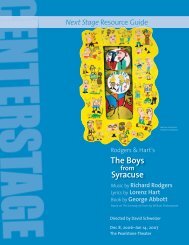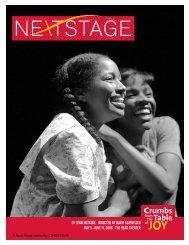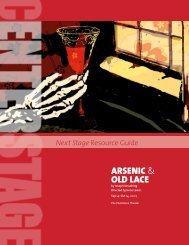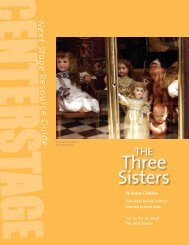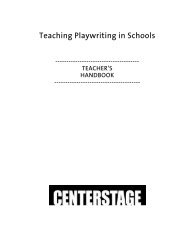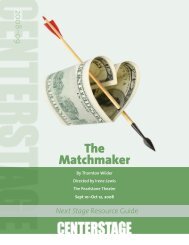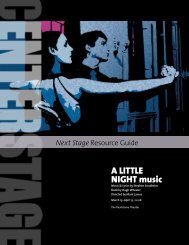Joe turner's Come and Gone - Center Stage
Joe turner's Come and Gone - Center Stage
Joe turner's Come and Gone - Center Stage
Create successful ePaper yourself
Turn your PDF publications into a flip-book with our unique Google optimized e-Paper software.
“[T]hat’s my workshed. I go out there…<br />
take these h<strong>and</strong>s <strong>and</strong> make something<br />
out of nothing. Take that metal <strong>and</strong><br />
bend <strong>and</strong> twist it whatever way I want.”<br />
—Seth, <strong>Joe</strong> Turner’s <strong>Come</strong> <strong>and</strong> <strong>Gone</strong><br />
“All my life I been looking for somebody<br />
to stop <strong>and</strong> stay with me…I take Jack<br />
Carper’s h<strong>and</strong> <strong>and</strong> it feel so rough <strong>and</strong><br />
strong. Seem like he’s the strongest<br />
man in the world the way he hold me.<br />
Like he’s bigger than the whole world<br />
<strong>and</strong> can’t nothing bad get to me.”<br />
— Mattie, <strong>Joe</strong> Turner’s <strong>Come</strong> <strong>and</strong> <strong>Gone</strong><br />
“I looked over <strong>and</strong> seen my daddy<br />
st<strong>and</strong>ing there. He was the same size<br />
he always was, except for his h<strong>and</strong>s<br />
<strong>and</strong> his mouth…his h<strong>and</strong>s were as big<br />
as hams. Look like they was too big to<br />
carry around.”<br />
—Bynum, <strong>Joe</strong> Turner’s <strong>Come</strong> <strong>and</strong> <strong>Gone</strong><br />
going to leave. The man is going to work, <strong>and</strong> the woman<br />
is going shopping, <strong>and</strong> the kid is going to drink the milk<br />
<strong>and</strong> go out, <strong>and</strong> this man is going to be left in there in<br />
this posture. And what he needs most is human contact.”<br />
And then I began to wonder who he was <strong>and</strong> why he was<br />
sitting there like that, <strong>and</strong> I said, “I am going to animate<br />
this boarding house <strong>and</strong> make the boarding house come<br />
alive <strong>and</strong> give these characters names <strong>and</strong> find out who<br />
this guy is <strong>and</strong> what is his story.” 3<br />
At this same time, Wilson was working on a collection<br />
of poems, “Restoring the House.” In this series, Wilson<br />
chronicled the story of a freed man searching for his<br />
enslaved wife who had been sold from Mississippi to a<br />
plantation in Georgia a few years before Emancipation.<br />
Struck by the idea of characters searching for one another,<br />
<strong>and</strong> the need for someone to “heal them <strong>and</strong> bind them<br />
together,” the storyline for <strong>Joe</strong> Turner’s <strong>Come</strong> <strong>and</strong> <strong>Gone</strong><br />
began to crystallize.<br />
A true Bearden aficionado, Wilson was not only influenced<br />
by the artist’s collages but also derived inspiration from<br />
Bearden’s life experiences. In <strong>Joe</strong> Turner’s <strong>Come</strong> <strong>and</strong> <strong>Gone</strong>,<br />
for example, Wilson’s vision of the Holly boarding house<br />
was partly formed by memories of his gr<strong>and</strong>mother’s<br />
boarding house, but it was also informed by the drawings<br />
Bearden had made of his gr<strong>and</strong>mother’s Pennsylvania<br />
boarding house. Furthermore, Wilson pays homage to<br />
Bearden’s life by actually representing Bearden through<br />
the young character of Reuben in <strong>Joe</strong> Turner. Like Reuben,<br />
Bearden had a sickly, childhood friend named Eugene who<br />
collected pigeons. The terminally ill Eugene made young<br />
Bearden promise that when Eugene died Bearden would set<br />
his pigeons free—a promise kept in Wilson’s play as it was<br />
in real life.<br />
While Bearden’s influence appears in the broad strokes of<br />
Wilson’s dramaturgy <strong>and</strong> inspiration, common elements<br />
can also be found in the finer details. For example, both<br />
artists are known for embracing—<strong>and</strong> repeatedly returning<br />
to—a particular set of motifs <strong>and</strong> images. These include the<br />
Blues, migration, trains, guitars, <strong>and</strong> out-of-scale physicality.<br />
As noted by Wilson scholar Joan Herrington, both men use<br />
“simple images <strong>and</strong> symbols, but [endow them] with great<br />
significance.” 4 Wilson himself observed that Bearden’s<br />
work often depicts “a huge oversized h<strong>and</strong> on a small<br />
body,” 5 <strong>and</strong> his plays follow suit, repeatedly emphasizing<br />
the skills, strength, <strong>and</strong> size of their characters’ h<strong>and</strong>s. In<br />
Fences, for instance, Wilson describes Troy as having “thick<br />
heavy h<strong>and</strong>s;” in The Piano Lesson, Boy Willie remarks on his<br />
father’s “big old h<strong>and</strong>s;” in Gem of the Ocean, Aunt<br />
Ester recalls that her son, Junebug, “Had big h<strong>and</strong>s;” <strong>and</strong><br />
in <strong>Joe</strong> Turner’s <strong>Come</strong> <strong>and</strong> <strong>Gone</strong>, Reuben tells Zonia about<br />
seeing a ghost who “just had on that white dress <strong>and</strong><br />
them big h<strong>and</strong>s.”<br />
Of course, it would be erroneous to suggest that the<br />
fullness of Wilson’s characters or plays could be gleaned<br />
merely from a textual study of h<strong>and</strong>s. Nevertheless, we<br />
can certainly gain a more nuanced underst<strong>and</strong>ing of<br />
Wilson’s playwriting by examining how he uses the<br />
imagery of h<strong>and</strong>s—<strong>and</strong>, more broadly, draws on the life <strong>and</strong><br />
artistic vision of Romare Bearden—to enrich his dramatic<br />
explorations of labor, love, <strong>and</strong> legacy within the African<br />
American experience. Finding in Bearden’s work a world<br />
that depicts “men with huge h<strong>and</strong>s <strong>and</strong> hearts, pressing<br />
on life until it gave back something in kinship,” 6 August<br />
Wilson also found his own inspiration: he, too, animates<br />
characters who press on through life’s hardships, held<br />
together by their sense of community <strong>and</strong> guided by the<br />
h<strong>and</strong>s of their ancestors. •<br />
1<br />
Many scholars <strong>and</strong> artists, including Wilson himself, cite the<br />
Bearden collage Piano Lesson (1983) as the inspiration for<br />
Wilson’s play of the same name. Others, however, credit the<br />
strikingly similar lithograph Homage to Mary Lou (1984) as<br />
the original inspiration.<br />
2<br />
Mark William Rocha: “August Wilson <strong>and</strong> the<br />
Four B’s: Influences,” in August Wilson: A Case Study, ed.<br />
Marilyn Elkins, pp. 10-11.<br />
3<br />
August Wilson, Conversations With August Wilson, p. 111.<br />
4<br />
Joan Herrington, I Ain’t Sorry for Nothin’ I Done, p. 24.<br />
5<br />
Rocha, p. 11.<br />
6<br />
August Wilson, “Foreword,” in Romare Bearden: His Life & Art,<br />
ed. Myron Schwartzman, p. 9.<br />
Top left: Two details from Romare Bearden’s Miss Bertha <strong>and</strong> Mr. Seth<br />
(1978). Upper right: Details from Bearden’s The Family Dinner (1968) <strong>and</strong><br />
Evening Meal of the Prophet Peterson (1964).<br />
Next <strong>Stage</strong>: <strong>Joe</strong> Turner’s <strong>Come</strong> <strong>and</strong> <strong>Gone</strong> |



